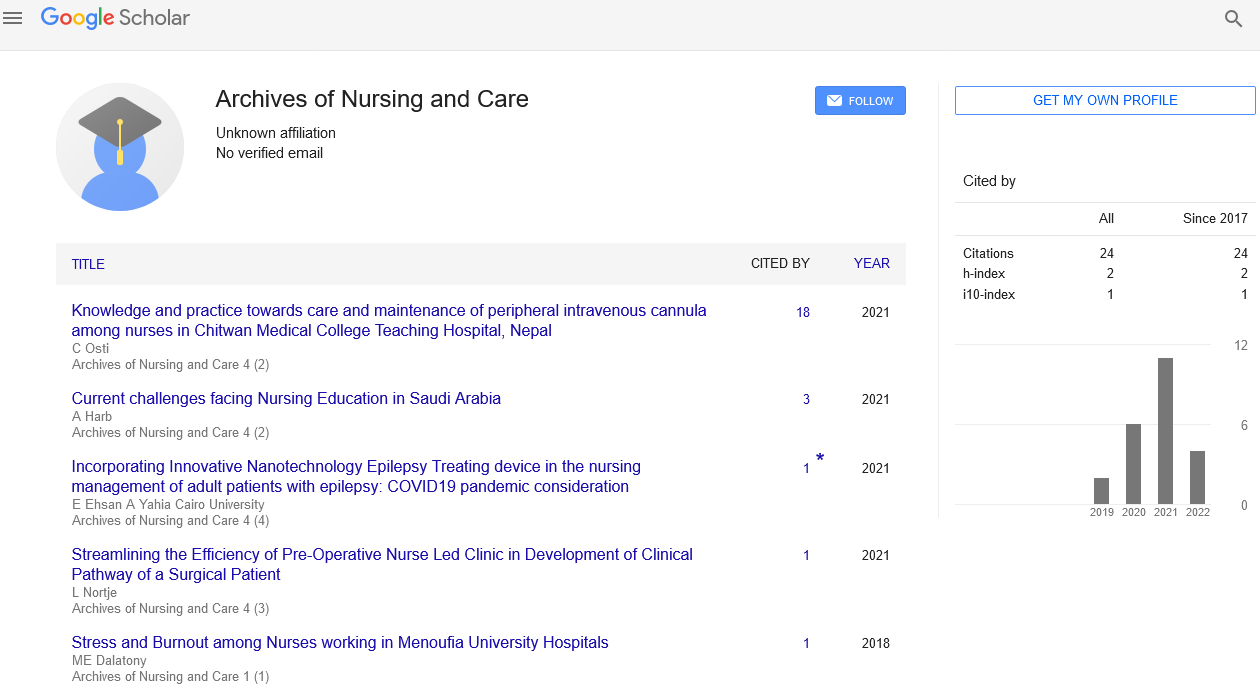Short Article - Archives of Nursing and Care (2018) Volume 1, Issue 1
Stress and Burnout among Nurses working in Menoufia University Hospitals
Mervat El Dalatony
Menoufia University, Egypt
Abstract
Background: More and more employees are experiencing stress on the job nowadays especially those working in the medical field. This stress can be due to work overload, high demands, poor working conditions, long working hours, lack of control or lack of social support and rewards. There is considerable evidence that stress can lead to various adverse effects on individuals, including somatic disorders, mental health problems or sense of tiredness.
Burnout among health care employees, mainly medical personnel, has become an occupational hazard with a prevalence in some clinical specialties ranging from 25 to 75 per cent. Burnout syndrome (BOS) was characterized as the experience of long-term fatigue and diminished interest, typically in the sense of the work. Therefore, burnout is regarded as the clinical manifestation of occupational stress. Burnout can have significant impacts on people such as job loss, family relationships, psychological disorders and addictive behavior. In terms of organizational outcome; job burnout causes absenteei sm, inefficiency in innovation and productivity loss. We expect that nurses are especially exposed to high levels of stress during their work, so we conducted the current work aimed at studying stress and burnout among nurses working in hospitals at Menoufia University
Methods: A cross-sectional study involved nurses working in Menoufia University Hospitals during the period from September- December 2018. Departments involved (Intensive care units including adult, pediatric, and neonatal ICUs), Medical Departments including (internal medicine, pediatric, hepatology departments), Surgical departments including (orthopedics-general surgery- ophthalmology & ENT). All registered nurses in Menoufia University Hospitals who were practicing during the data collection period of the study were invited to participate. Those who had duration of employment of less than one year were excluded.
The number of eligible nurses for the study was 209. The purpose of the study was explained to the nurses to get their approval. The number of participants who agreed to share in the study (158) with a response rate of 75.59%.
Study Tools: Data were collected using a self-administered questionnaire composed of 4 sections; Section 2 (Sociodemographic and work characteristics): including age, marital status, and level of education, working hours per week, working years, and occupation, Section 2 (Job satisfaction survey): A survey which includes (30) questions related to nature of work, interpersonal relationship, pay and allowances, working environment, training, management policies, personal growth, and career development. Based on nurse’s response, they are classified as Satisfied, Average, or dissatisfied, Section 3(Stress and burnout questionnaire): - This brief valid inventory has been designed to discover the warning signals of excessive stress based on participant own evaluation of his life over the last 3-6 months. The total score is (50) with a high score indicating a high level of stress and burnout, and Section 4 (Burnout Prevention Assessment): include (23) statements reflecting important ways that participant use to prevent burnout. Based on the total score, the participants’ response was categorized as follows: coping well with stress, coping with stress to some extent, or unable to cope with stress.
Data analyzed using IBM SPSS Statistics for Windows version 21.0. Descriptive statistics including frequency, percentages, arithmetic mean (X) and standard deviation (SD) were used to describe the study population.
The relationship between mean stress score, demographic factors, and work-related factors were determined used independent t-test in case of a dichotomous variable, and One-way analysis of variance (ANOVA) is used to determine whether there are any statistically significant differences between the means of three or more independent (unrelated) groups. Correlation is used to study the relationship between two quantitative, continuous variables, for example, working hours, working years, and stress and burnout score. Pearson’s correlation coefficient (r) is calculated to measure the strength of association between the two variables.
The binomial logistic analysis is used for burnout using independent significant variables in the univariate analysis. The significance level was set at P < 0.05.
Ethical Clearance: Objectives of the study, procedures, types of information to be obtained, and publication were explained to participants. Informed consent was obtained from each participant at the beginning of the study. Collected data were confidentially kept.
Results: A Significant association was found between Gender, educational level, Department, Job satisfaction on one side and stress and burnout score on the other side. A significant finding of this study is that nurses working in critical care areas are experienced high stress and burnout scores which may be explained by working environment in critical care area which is closed, noisy, hyperactive and highly technical and exposure to highly stressful and emotional situations, such as the relapse or death of a patient. There is an inverse relationship between stress and job satisfaction, as stress goes up, job satisfaction falls.
But no significant association exist between age, residence, smoking and the score (P> 0.05). A significant correlation was found between working hours and stress and burnout score. But no significant correlation existed between working years and the score. In this study, about 67% percent of nurses are unable to cope with stress, with only 3.2 percent cope well with stress. Stress with high mean stress score for those who are unable to cope with stress but this relation was not significant (P >0.05). The binomial logistic analysis found that education, working hours/ week are independent significant factors associated with stress among the study group. The only significant factor associated with burnout prevention and the ability to cope with stress is working years. No significant association was detected between age,sex, residence, education, and department, type of work and burnout prevention categories of participant nurses.
Conclusion: A comprehensive approach directed toward control of stress among nurses is required including the review of the working conditions, working environment, number of working hours, and Job satisfaction of nurses. Involvement of hospital administration to provide solutions to control stress among nurses include staff meeting, staff educational program, job rotation to ensure skill use, giving staff empowerment. Counseling of nurses with a high-stress score is requiredto alter their behavior and increased capabilities for coping with stress.
Keywords: Burnout, Healthcare Workers, Stress at Work, Occupational, Stress Management.

